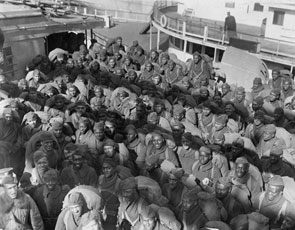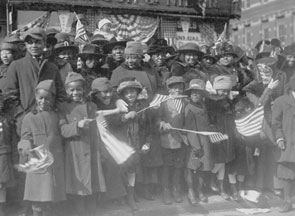The Negroes’ Temporary Farewell
Jim Crow and the Exclusion of African Americans from Congress, 1887–1929
World War I And The Great Migration
 African-American troops of the 351st Field Artillery gather on the deck of the U.S.S. Louisville in February 1919 during their return voyage home from Europe.Image courtesy of National Archives and Records Administration
African-American troops of the 351st Field Artillery gather on the deck of the U.S.S. Louisville in February 1919 during their return voyage home from Europe.Image courtesy of National Archives and Records AdministrationThroughout American history, wartime necessity has often opened new political and social avenues for marginalized groups. This familiar scenario played out after the United States intervened in the First World War in April 1917. By participating in the war effort, women suffrage activists made a compelling, and ultimately successful, case for voting rights: After all, how could America protect democracy abroad without extending it to half the population at home? Likewise, Black Americans furthered their claim for racial equality at home by their contributions on European battlefields and on the home front filling industrial jobs.
Congress passed the Selective Service Act on May 10, 1917, which required all able-bodied men ages 21 to 31 to register for military duty.114 On registration day, July 5, 1917, more than 700,000 black men enrolled. By war’s end, nearly 2.3 million had answered the call. In less than two years, more than four million draftees swelled the ranks of the U.S. military. Of these, 367,000 were African Americans who were drafted principally into the U.S. Army. Segregation in military service reflected the segregation in civilian life. Blacks were barred from the Marine Corps and the Army Air Corps, and in the U.S. Navy they were assigned only menial jobs. African Americans had to fight to establish a black officer training program.115 On the battlefield, many infantry units in the all-black 92nd U.S. Army Division distinguished themselves.116
Arguably the most profound effect of World War I on African Americans was the acceleration of the multi-decade mass movement of black, southern rural farm laborers northward and westward in search of higher wages in industrial jobs and better social and political opportunities. This Great Migration led to the rapid growth of black urban communities in cities like New York, Chicago, St. Louis, and Los Angeles.117 While relatively small groups of southern African Americans migrated after Reconstruction to border states such as Kansas and into the Appalachians, it was not until the imposition of Jim Crow segregation and disfranchisement in the South that large numbers of blacks left their homes and families to search elsewhere for a better life. Still, in 1910, nearly 90 percent of American blacks lived in the South, four-fifths of them in rural areas.
Emigration from the South gained more traction with the advent of several important developments, chiefly economic, beginning in the second decade of the 20th century. 118 In the South the depressed cotton market and a series of natural disasters reduced even the rare independent black landowner to sharecropping or tenant farming, trapping him in a cycle of indebtedness. Military conscription and the slackening of European immigration caused massive labor shortages in the North, just as war production created an insatiable demand for industrial goods. Labor shortages provided blacks with jobs in the steel, shipbuilding, and automotive industries as well as in ammunition and meat packing factories.
Many found the promise of economic opportunity irresistible, though this was not the only element pulling blacks northward. Contemplating departure from the South, Representative George White said to the Chicago Daily Tribune, “I cannot live in North Carolina and be a man and be treated as a man.” In an interview with the New York Times, he encouraged southern black families to migrate west, “los[ing] themselves among the people of the country.”119 Historian Steven Hahn suggests that a “pronounced self-consciousness” encompassed both social and political motivations for emigrating: “searches for new circumstances in life and labor, new sites of family and community building, new opportunities to escape economic dependence…” Hahn expains that the movement not only created new political vistas for migrating blacks but “also served as a large and powerful political transmission belt that moved and redeployed the experiences, expectations, institutions, and networks” forged in the black community during slavery and in Reconstruction, which would fundamentally shape emerging centers of African-American culture and thought in the North.120
Whether their motivation was economic, political, individual, or communal, immense numbers of African Americans streamed northward. By one estimate, roughly a half-million blacks migrated to northern cities between 1915 and 1920, and between 750,000 and one million left the South in the 1920s. Chicago’s black population soared 600 percent between 1910 and 1930. In the same 20-year period, Detroit’s African-American community grew 2,000 percent—from 6,000 individuals to about 120,000.
This massive demographic shift dramatically altered African-American history culturally, politically, and socially, producing during the 1920s a period of black artistic expression in literature, music, and thought known as the Harlem Renaissance. Among those who participated in this cultural moment in northern Manhattan, which raised black consciousness nationally, were poet Langston Hughes, writer Zora Neale Hurston, and scholar and intellectual W. E. B. DuBois. A new sense of African-American culture emerged, stoked by such leaders as Marcus Garvey, an advocate for black separatism and repatriation to Africa. Garvey emigrated from Jamaica to New York City in 1916 and, within a few years, founded the Universal Negro Improvement Association (UNIA), enlisting thousands of members.121 Interestingly, UNIA found much support in the recently transplanted community of southern blacks, who helped establish many UNIA chapters in the South by sharing the organization’s literature with their relatives back home.122 Skyrocketing black populations in urban wards created new opportunities for political activism. Slowly, African Americans were elected to important political offices; for example, Oscar De Priest, a native Alabamian and future Member of Congress, became a member of the Chicago city council in 1915.
Footnotes
- See Adam P. Plant, “Selective Service Act of 1917,” in Brian K. Landsberg, ed., Major Acts of Congress, Volume 3 (New York: Macmillan Reference/Thompson Gale, 2004): 178–181; see also Robert W. Mullen, Blacks in America’s War: The Shift in Attitudes From the Revolutionary War to Vietnam (New York: Monad Press, 1973).
- Franklin and Moss, From Slavery to Freedom: 361–362.
- Ibid., 366–374. Among these, the 15th New York Regiment of the 369th U.S. Infantry stood out. It was the first Allied unit to reach the German border on the Rhine River, and never yielded a trench or lost a member to capture. The French awarded the entire regiment the Croix de Guerre.
- For more on black migrations in the post-Reconstruction period and the 20th century, see Nicholas Lemann’s The Promised Land: The Great Black Migration and How It Changed America (New York: Knopf, 1991); Nell Irvin Painter, Exodusters: Black Migrants to Kansas After Reconstruction (Lawrence: University Press of Kansas, 1986); Douglas Flamming, Bound for Freedom: Black Los Angeles in Jim Crow America (Berkeley: University of California Press, 2005). For a concise essay on the historical literature on this topic, see Joe William Trotter, “Great Migration: An Interpretation,” in Africana 3, Kwame Appiah and Henry Louis Gates, Jr., eds. (New York: Oxford University Press, 2005): 53–60.
- See the charts on regional black population shifts at the end of this essay. Migration was a long and vexing question in the South and among African-American communities generally. In 1822, the American Colonization Society (ACS) acquired a small tract of land in the British colony of Sierra Leone in sub-Saharan Africa and named it “Liberia”–a settlement of people “made free.” Approximately 15,000 free blacks from the United States migrated to Liberia over the next 20 years. Though the ACS initially received support from several prominent politicians, vocal objectors and an economic depression in Liberia killed the project by the 1830s. After Reconstruction, the issue of African migration was rekindled; however, many leading blacks, among them John Langston, opposed foreign emigration. “Abuse us as you will, gentlemen,” Langston told Democrats. “There is no way to get rid of us. This is our native country.” Congressional Record, House, 51st Cong., 2nd sess. (16 January 1891): 1480–1482; see also William Cohen, At Freedom’s Edge: Black Mobility and the Southern White Quest for Racial Control, 1861–1915 (Baton Rouge: Louisiana State University Press, 1991).
- “Sees No Hope in South,” 26 August 1900, Chicago Daily Tribune: 7; “Southern Negro’s Complaint,” 26 August 1900, New York Times: 8. White lived in Washington and Philadelphia for the rest of his life. He was among eight black Congressmen in the 19th century who left the South after their service in Washington.
- See Hahn’s discussion in A Nation Under Our Feet: 465–476; quotations on pages 465, 466.
- Edmund David Cronon, Black Moses: The Story of Marcus Garvey and the Universal Negro Improvement Association (Madison: University of Wisconsin Press, 1955): especially pages 204–207, 212–220.
- Hahn, A Nation Under Our Feet: 470–473.

